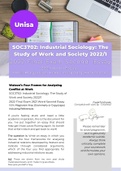Watson’s Four Frames for Analysing
Conflict at Work
SOC3702: Industrial Sociology: The Study of
Work and Society 2022/1
2022 Final Exam 2621 Word Second Essay FadeToWords
100% Plagiarism Free (Grammarly or Copyscape) Compiled with care by - CreativeJ
Including References
If you're feeling stuck and need a little
academic inspiration, this is the document for
you. I've put together an essay that should
help get those juices flowing again. So banish Please remember
that writer's block and get back to work! to avoid plagiarism,
as it is genuinely
The question is: Write an essay in which you academic suicide.
discuss the four frameworks for analysing Always think
industrial relations developed by Watson and, critically, complete
indicate through considered arguments,
your coursework
which of the four you find appropriate for
and formulate your
addressing industrial relations issues.
own opinions.
N.B. These are drawn from my own past study
materials/answers, and I make no guarantees.
Now give yourself a hug.
,A few important details
about this document
2621
Words
This essay is carefully constructed with the or 10 Pages,
intent to inform a knowledgeable audience if you're counting.
and is presented in a formal tone of voice.
I have followed academic writing conventions
and the Harvard referencing style and
format.
0%
British English Plagiarism score:
Checked for: Checked on Copyscape
Spelling, Grammar, and Punctuation or Grammarly
(and a stiff upper lip).
, Watson’s Four Frames for Analysing Conflict at Work
Table of Contents
Watson’s Four Frames for Analysing Conflict at Work 1
Table of Contents 1
2. Question 3 2
Watson’s Four Frames for Analysing Conflict at Work 2
2.1 Introduction 2
2.2 The Free-Market School of Thought 2
2.3 The Unitary Framework 3
2.4 The Pluralist Approach 4
2.5 The Radical/Critical Perspective 6
2.6 Argument for the Critical Viewpoint Description of Current Labour Relations 7
2.6.1 Criticism of Free-market School of Thought 7
2.6.2 Criticism of the Unitary Framework 8
2.6.3 Criticism of the Pluralist Approach 8
2.6.4 Radical/Critical Standpoint to Best Describe Current Labour Relations 9
2.7 Conclusion 10
3. List of References 10
SOC3702, 2022/1, June Examination 1
, 2. Question 3
Watson’s Four Frames for Analysing Conflict at Work
2.1 Introduction
Watson uses a traditional sociological paradigm to explain industrial interactions in
the four analytical frameworks of reference (Lesufi 2020:57). In this essay, the
distinguishing characteristics of each method are discussed, and it is argued which of
the four approaches best depicts the current dynamics of industrial relations. The first
examines Adam Smith's influence on the free-market school of thinking. Then there
is a discussion of Emile Durkheim's structural functionalism, which influenced the
unitary framework and pluralist approach. After that, Karl Marx's declarations support
a discussion about the radical/critical viewpoint. Finally, the radical/critical method is
compared against the other three viewpoints to fully convey modern society's
industrial relations dynamics.
2.2 The Free-Market School of Thought
The free market determines the pricing of all goods and services. As a result,
employment relationships are based on service trading and are subject to optimal
market value. Workers and capitalists deliberately engage in a transactional
relationship as they attempt to make a livelihood while capitalists follow their money
motivations. Each party is focused on its gains, and this system will eventually benefit
all involved (Lesufi 2020:57). In other words, this assumption offers a self-centred
definition of employment relationships in which both employers and employees have
self-serving objectives. Both parties join the market freely, hoping the trade will
achieve their aims at a fair price. The classical political economy's division of labour
supports the free-market school of thinking, in which specific social groupings are
disconnected from the means of production and employees sell their labour for a
living wage. The owners of the three production components—land, labour, and
capital—collaborate to foster social interaction. The landowners have historical rights
to the property, while the labourers give labour and the ability to work. Capitalists
finance the industrial processes, raw materials, and labour force.
SOC3702, 2022/1, June Examination 2




